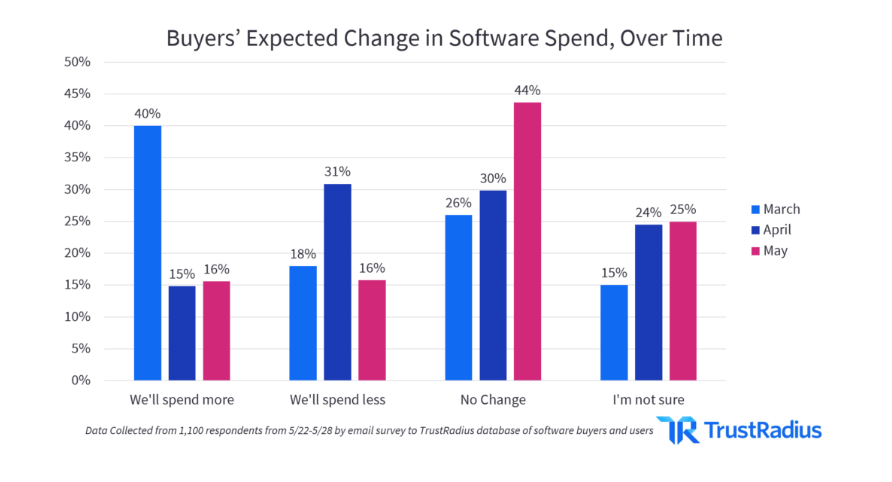How Digital Transformation Is Empowering SMBs During the Pandemic
By: Vikas Agrawal

In addition to threatening our personal wellbeing and healthcare systems, COVID-19 has jeopardized the stability and survival of enterprises, hitting small to medium businesses (SMBs) particularly hard. Unlike larger companies, SMBs have fewer assets, smaller cash reserves, and a lean business structure leaving them unable to significantly shrink expenses by cutting less-essential positions or processes.
A recent TrustRadius survey found that respondents at 50% of all businesses felt somewhat or greatly threatened by the pandemic, but that rose to 60% for companies with under 10 employees. SMBs are also twice as likely to feel greatly threatened than the average company.
While SMBs have been slowly ambling towards digital transformation, COVID-19 sped up the shift dramatically. Some 70% of small business owners have added new digital capabilities, or enhanced existing ones, since the beginning of the pandemic.
No wonder software spending spiked in March, with 40% saying they expected to lay down more cash than usual on software. The surge then tapered off in April and May, as companies completed their purchases and settled down to master them. Only 15-16% expected to spend more on software than usual in April and May.
But doing digital hasn’t been only about supporting work-from-home arrangements. Digital transformation is proving to be a lifebelt for SMBs during COVID-19, improving performance and productivity, reducing costs, and supporting new and better customer experience that will serve them well in the long term.
Identify Opportunities and Risks Before they Arrive
SMBs rushed digital transformation to increase their agility and resilience during turbulent business times. Embracing data analytics as part of a successful digital transformation strategy enables enterprises to identify risks on the horizon and take action to mitigate them before they arrive.
Business intelligence (BI) tools support automated data gathering, processing, visualization and analysis that allows business leaders to proactively spot new opportunities and make proactive decisions that help them to thrive. Effective business strategy is rooted in data insights and predictions.
What’s more, digitally transformed companies flatten silos that keep different teams from data-driven insights, smoothing data pipelines and workflows to maximize access to data so that every department can optimize operations for greater revenue.
Increase Business Efficiency and Reduce Costs
In straitened circumstances, it’s more important than ever that small to medium businesses are as efficient as possible. Digitally transformed organizations can plumb data both to reduce costs, and to improve their competitive advantage to increase revenue.
It’s vital to be able both to dig deep and view performance on a granular level, and to step back and see high-level visualizations that show patterns of demand and productivity.
Automated data workflows improve the flow of data that helps developers build better apps, sales teams follow up on leads at the right time. Marketers, meanwhile, are double checking their customer success signals to create personalized campaigns that boost ROI. Flatter business hierarchies permit nimble teams to seize the business moment. What’s more, advanced BI platforms enable companies to monetize data through embedded analytics, opening up additional much-needed revenue streams.
Digital Delivery of Services and Products
As lockdowns have swept across the world and consumers have shied away from in-person interactions, successful SMBs have pivoted to the online delivery of products and services as fast as possible. Businesses needed to quickly connect with a digital ecosystem made up of digital payment solutions, online stores, digital inventory tracking, remote consulting and more.
A digital sales and delivery platform allows SMBs to access a broader market and extend their reach around the globe. In South-East Asia, the SARS epidemic had the unexpected effect of kickstarting the nascent eCommerce movement, and it seems that the coronavirus is having a similar effect in speeding up the digitalization of business worldwide.
Every aspect of our lives is becoming more digital thanks to COVID-19, so small businesses need to meet consumers where they are to be found.
Maintain Excellent Customer Experience
A large number of companies that so far resisted pressure to replace in-person interactions with digital services now have no choice but to make the leap. Healthcare, banking, and retail businesses needed to find a way to deliver excellent CX, even when they can’t meet with their customers face to face.
They’ve turned to digital platforms that support self-service portals, online ordering, connected customer support, and similar services. Facebook promoted its instant-reply messages that use templates to automatically respond to user queries.
SMBs have also adopted AI-powered chatbots that operate on Facebook Messenger, Instagram Direct Messages, and WhatsApp to connect with customers in real time without keeping anyone waiting.
Support Remote Work
Work-from-home has become the norm now, requiring companies to adopt digital tools so that their employees can continue their tasks remotely. Employees need to be able to communicate and collaborate in real time, share resources and documents and access business data, all without causing any drop in security.
As a result, SMB owners fast-tracked adoption of SaaS tools like project management software; video conferencing platforms; messaging channels; secure resource sharing like Dropbox, Google Drive, and Microsoft Teams; secure document signing for remote contracts, and more.
Some had to convert paper documents to digital, and establish automated workflows to make it easier for employees to work remotely.
Optimize Supply Chains
Digital transformation supports a connected, optimized supply chain that is fully visible from beginning to end, and that’s exactly what SMBs need right now.
The pandemic disrupted supply chains, throwing deliveries off track and interrupting production at source, so businesses seriously need transparency into their supply chain.
An optimized supply chain also improves customer service by enabling consumers to track the progress of their order, and helps businesses to place orders at the right time.
Digital Transformation Is More than Life Support for SMBs
There’s every reason to expect that SMBs will maintain and continue their digital transformation beyond the end of the pandemic restrictions. Approximately 42% of businesses say they intend to keep their new digital innovations after the threat of COVID-19 recedes, and 36% plan to expand existing digital tools post-pandemic.
Digital transformation helps small business owners run a more efficient organization; spot opportunities and risks early; support remote work; digitally deliver services, products, and excellent customer support; and optimize supply chains, boosting their bottom line and increasing viability for the long term.
3370 Views













